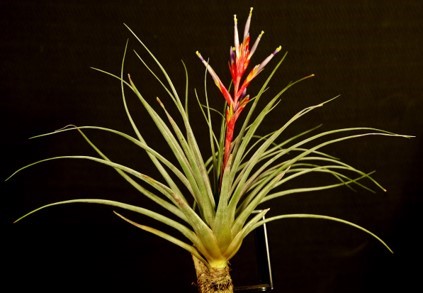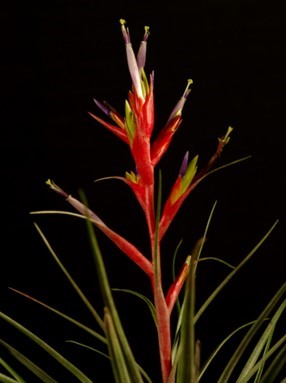Tillandsia canescens
Click thumbnails for full size, scaled to a new window.
Tillandsia canescens



| Peter Tristram 12/13 |
Chris Larson 04/21 |
Peter Tristram ... "a tiny Caribbean species which bloomed for me last winter. I have managed to obtain canescens from a few sources and all are slightly different.
A mature plant is about 100 mm tall"



| Greg Aizlewood 11/22 "John's clone" |
Greg Aizlewood 11/22 "Peter's clone" |
Greg Aizlewood 11/22 ... "A couple of clones of a plant I first obtained from John Arden as a seedling, the second clone came from Pete Tristram. They both, we believe, came from Jeff Kent but bare only a vague resemblance to the plants on Derek's Disc"
Tillandsia canescens Swartz, Prod. Veg. Ind. Occ. 57. 1788.
Desc from S&D p959-60
Plant stemless, less than 20 cm high.
Leaves numerous in a narrowly crateriform rosette, to 23 cm long, densely and minutely appressed-lepidote throughout;
Sheaths ovate, 3-6 cm long, brown;
Blades linear-triangular, attenuate, flat for most of their length, to 1 cm wide at the base.
Scape erect or ascending, slender;
Scape-bracts erect, imbricate, the lower foliaceous, the upper broadly ovate, their foliaceous blades elongate but shorter than the inflorescence, membranaceous, reddish, lepidote.
Inflorescence subdigitately compound from a few simple branches or rarely simple, pyramidal, often much exceeded by the leaves;
Primary bracts like the upper scape-bracts, not more than half as long as the axillary spikes but their blades often exceeding the lower ones;
Spikes short-stipitate, divergent, lanceolate, acute, 25-30 mm long, complanate, 3-flowered or 4-flowered with 1 or 2 sterile bracts at the base;
Rhachis slightly flexuous, slender, angled, glabrous.
Floral bracts erect, imbricate, elliptic, obtuse, 13-17(-24) mm long, about equaling the sepals, two to three times as long as the internodes, exposing the rhachis, carinate, chartaceous, nerved, soon glabrous, reddish;
Flowers subsessile.
Sepals elliptic-oblong, obtuse, even, subglabrous, connate posteriorly for 5 mm;
Petals linear, 3 cm long, violet;
Stamens and pistil exserted.
Capsule cylindric, acute, 28 mm long.
Type. Swartz s n (holotype BM, GH photo), without exact locality, Jamaica. DISTRIBUTION. Epiphytic and saxicolous, 530-900 m alt, Cuba, Jamaica.
CUBA. PINAR DEL RIO: Sumidero, 13 Aug 1912, Shafer 13730 e p (SV, US); Sierra del Sitio Santo Tomas, 12 Jun 1923, Ekman 16678 (S); Pan de Guajaibon, 27 Dec 1936, Acutia 10730 (SV); Rangel, Sierra del Rosario, Jul 1946, Alain 578 (LS, US). WITHOUT EXACT LOCALITY: Wright 3273 (BM, GH, US). JAMAICA. CORNWALL, Trelawny: Troy, 6 Dec 1904, Harris 8831 (BM); 14 Aug 1965, Hespenheide 1176 (MICH); Manchester: Peckham Woods, 27 Dec 1917, Harris 12770 (BM, US); Christiana, 3 Jul 1955, Howard & Proctor 14361 (IJ, US); St. James: Sweet Water, 23 May 1953, Proctor 7973 (IJ, US); Westmoreland: Dolphin, Jan 1844, Purdie s n (K).
Tillandsia canescens: A Rare Species from the Greater Antilles by Lucia Hechavarria Schwesinger in JBS 55(3): 136. 2005
Tillandsia canescens, an endemic species of the Greater Antilles was described by the memorable Swedish botanist Peter Olof Swartz (1788), as having the leaves linear-erect, the scape gray, erect, and with three spikes. The type specimens from Jamaica are deposited in the herbarium of the Swedish Museum of Natural History (S, Holotype R-6135) and that of the British Museum of Natural History (BM, Isotype).An expanded description of the species, with special emphasis on the inflorescence was provided by Swartz almost one decade later, in his work: Flora Indiae Occidentalis (Swartz 1797). Swartz also described the habit of the plant as an epiphyte found in vegetation near the seacoast.
Tillandsia canescens is considered a rare and uncommon species in Jamaica, with known populations confined to a small area along the central axis of the island, on limestone ledges, cliffs and crags, rarely on trees, at 2000-3000 feet (approx. 600-900 m) above sea level (Proctor & Read 1972).
The first record of the species outside of Jamaica was made by Grisebach (1866), based on a specimen collected by Charles Wright (No. 3273) in Pinar del Rio, Cuba (Howard 1988).Wright (1811-1885) made many plant collections throughout Cuba on his trips between 1856 and 1867. These collections provided the basis of the works "Plantae Wrightianae, e Cuba Orientali" (I and II) and "Catalogus Plantarum Cubensium", all of them written by Grisebach (1860, 1862, 1866) and also for the Flora Cubana of Sauvalle (1873). These works are still valuable references today for students of the Cuban flora.
In Cuba, Tillandsia canescens prefers rock outcrops (FIGURE 38) in the western-most province, Pinar del Rio, in the highlands of Sierra del Infierno, Sierra de Vinales, and the northern side of Pan de Guajaibon (694 m elevation). It is found in isolated colonies of 3 to 5 individuals in varying stages of growth. The rosettes adhere strongly to the bare rock by means of fine and tough roots (FIGURE 39).The plants are small, reaching 25 cm tall in flower. The dark green leaves are succulent, chartaceous, and flexible, and are densely covered with cinereous scales that, as the Latin name implies, give the plant a grayish aspect. The inflorescence is simple or compound-subdigitate, the scape is thin with foliose and imbricate green bracts; the flowering spikes are short, flattened, to 4 cm long, and with 3-5 flowers. The floral bracts are dark red and contrast nicely with the blue flowers, the green-gray foliage, and the background of lichen-encrusted rocks (FIGURE 40). Flowering and fruiting occurs in January to March. No pollinators have been observed visiting its flowers.
Updated 20/02/23





